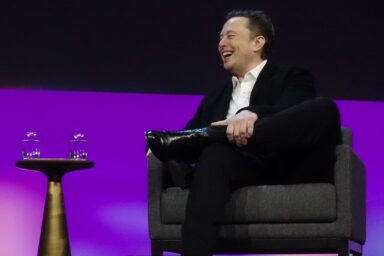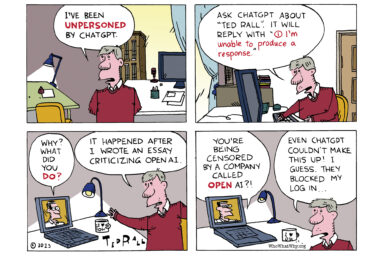We’ve got a lot of dumb stuff going on in our heads. There’s an industry that wants to replace it with new sounds. But are they better?
For the past several weeks — months? Years? — I have had the very beginning of James Taylor’s “You’ve Got a Friend” in my head. Just the start:
🎵“When you’re down…”🎵
And so it is: “When you’re down” when I’m cooking. “When you’re down” when I’m getting dressed. “When you’re down” when I’m staring blankly at my dog. “When you’re down” when I’m staring at any dog. Occasionally I’ll add “… and troubled,” but that seems superfluous.
“When you’re down” is not playing, far as I can tell, because I am down (or troubled, or need a helping hand), or at least no more than usual. “When you’re down” seems to be looping up there only to satisfy whatever demands of mental noise my brain demands, and not because of any fondness for James Taylor.
Because let me be clear: I don’t like James Taylor’s music. My favorite thing James Taylor ever did was co-starring in Two-Lane Blacktop, an excellent, nihilistic film that not only didn’t ask him to sing but barely required him to speak. He was great in that. He drove fast.
So: Why is “When you’re down” in my head? Is it necessary? Is it doing something important? Does it mean that James Taylor is somehow, God forbid, a part of me?
Like Ritalin, Administered One Sick Beat at a Time
Perhaps sensing my disquiet, Apple recommended a free trial of an app called Endel. Endel, based in Berlin, claims that “we are not evolving fast enough” and “our bodies and minds are not fit for the new world we live in” — traffic, social media, true-crime podcasts — so “we need new technology to help our bodies and brains adapt to the new world.”
The sluggishness of our evolution has, per Endel, resulted in anxiety, depression, and lack of sleep. To that end, Endel proposes to create personalized soundscapes that adjust to things like heart rate, activity level, and weather for all possible genres of human experience, from Study to Recovery to Sleep to Grimes.
I spent my free trial listening to a Deeper Focus soundscape. (I didn’t hook myself up to a wearable device to share heart rate etc.) And indeed, when I worked, I did seem to be more Deeply Focused than otherwise. Time went away, in the manner of reported flow states. It was both kinda interesting and sorta neat.
But I am suspicious of any new technology that wants to “help our bodies and brains adapt to the new world.” It’s not just Endel, which has raised more than $120 million in investments. Other apps, like Vibe and Wavepaths, are vying to become the household names of biometric, AI-generated “wellness music.” Meanwhile, Spotify, Amazon, and Apple want to connect music, AI, and wearable tech to create full-time listeners who exchange Focus or Recovery for the biometric data you generate when you’re Focusing or Recovering.
(Along these lines, I also wrote about how one company wants to use your favorite playlist, plus some artificial intelligence, as a kind of stress-reducing “medicine.”)
So, after Endel’s free trial ended and I could ruminate once again without the curse of Deeper Focus, I wondered what might be lost when technology offers to become the new soundtrack of our minds: variable to moods and weather, optimized by science and pop stars, and always monitoring. What becomes of poor, fragmentary James Taylor?
Daydreaming + Ph.D.s
When I fret about matters of a cognitive nature, I often pester the nearest cognitive neuroscientist I know — which, unfortunately for Jonas Kaplan, is Jonas Kaplan.
Kaplan is an associate professor at the University of Southern California’s Brain and Creativity Institute and codirector of the school’s Dornsife Cognitive Neuroimaging Center. Why, I ask him, do I have James Taylor in my head when I’m trying to do non-James-Taylor-related activities?
He chalks it up to “mind-wandering.” You know all the stuff that’s going on in our brains in between all the stuff that we’re supposed to be doing? That’s mind-wandering (which is another way of saying “daydreaming + Ph.D.s”). It’s a concept so shifty that even neuroscientists discovered it kind of accidentally. They noticed that the brains of people in scanners were strangely active in the downtime between tasks — when the participants weren’t focusing on anything in particular.
“There are these special systems that come online when people are mind-wandering,” he said. ”It’s thinking about other times and places, and meaning-making — about trying to interpret what’s happening in your past and future.”
The Psychic Jukebox of Garbage
Kaplan says they see the same systems light up when people read good stories. In those intervals between all the things we’re supposed to be doing, we’re shuttling around in time, weaving our own story. Maybe a snippet of James Taylor is a kind of motif in my narrative.
“You sing that song once, and then it comes to you the next time you’re in that situation,” he said. Indeed. That song, and other songs, and commercial jingles, and funny lines from Office Space, and things you should’ve said that one time but didn’t: “They become almost like these ritual-type things.”
When we’re not doing something “important,” these memes become the selections in a psychic jukebox of garbage that plays in the dive bar of our minds. There we sit, drink in hand, wondering how we got here, telling the story of how we got here.
And like any dive bar, the experience of mind-wandering can be good or bad.
James Taylor, James Taylor, James Taylor
Research suggests that mind-wandering comes in a few flavors. One is negative, “related to tortured self-examination or anxious self-doubting.” The other is positive, “reflecting an acceptance of inner experience and elaborated imagery and fantasy” — AKA creativity.
We’ll get into creativity later, but as for the negative: Not only can it lead to self-doubt, it can also keep us from doing that important stuff. In the case of James Taylor, I cannot rule out that it starts to feel like a bit of a tic. It’s silly and not unpleasant, but it may be an obsessive mental move, like a dog chewing a bald patch into its leg. Maybe I’d be finishing a neuroscience Ph.D. if not for James Taylor?
“One of the extremes of this is the kind of excessive thinking you have in [obsessive-compulsive disorder],” said Kaplan. “You have the same thought over and over again, you can’t stop having it. Or you do the same sort of behavior in a compulsive kind of way. There’s a little bit of that in these songs that become repetitive for us, as it becomes these habits of thought.”
But now, here come these companies, like Endel, with new technologies that want to optimize your thoughts. To replace those eclectic selections in your “jukebox” with “generative” soundscapes, modulated by artificial intelligence, informed by our biology and environment, that will maximize focus and keep us from… wandering off.
The implication underlying Endel and its kin being that wandering is bad, and focus — clean, earnest, work-centered focus — is good.
Ambient Music Becomes a Coping Strategy
Using music as a tool to narcotize people against the traumas of modern life isn’t new. Composer Brian Eno’s observations of anxiety at airport terminals inspired him to create 1978’s “Ambient 1: Music for Airports.” It’s more an art installation than an album, and designed to be, in Eno’s words, “as ignorable as it is interesting.” Eno ran musical elements — piano, choir — on looped tapes of differing lengths, such that the resulting “music” was partially randomly generated. “Music for Airports” is not intended to provoke an emotional or intellectual response but to act as a cognitive janitor, sweeping the noise aside to allow the listener to feel, or think, whatever they want. Thus: the birth of “ambient music.”
Listen for yourself. In fact, listen while you read this (just as I listened as I wrote this) and see if it awakens a superbloom in the desert of your conscious mind.
The spiritual spawn of “Music for Airports” is everywhere. Spotify has about a million “focus”-themed playlists, as does YouTube, some of which are epic eight-hour mud-mask murmurings.
Music is indeed becoming an official wellness tool, per a Global Wellness Report:
A Samsung UK study found that compared to 2019, roughly a quarter of millennials are now listening to over five hours of music a day — and over half rate music their number one “feel-good” source in 2020. A global study from NYU, McGill University and the University of Barcelona found that music was the number one way people were tackling anxiety during COVID-19 (more than sex, alcohol, working out, etc.), and that music was the only solution that actually lowered their depression. Spotify reported that global listening time for their mental health playlists doubled in 2020.
To understand the rise of music-as-medicine, it’s important to understand how it coincides with a certain $2 billion industry: meditation — and particularly the corporatized, work-focused brand called “mindfulness.”
Famous People Are Whispering in My Ears
Two apps — Headspace and Calm — dominate here. Headspace is looking at more than $100 million in annual revenue and offers meditations, yoga, workouts, and, of course, music. Under the app’s Focus tab, there’s music from Erykah Badu, St. Vincent, Arcade Fire, and an 84-minute piece from film-score composer Hans Zimmer “to give your focus an epic soundtrack.” (I use Headspace and have listened to Zimmer’s banger more than once, which does indeed make me feel as focused as director Christopher Nolan plotting out an overly complex movie.)
Bringing in celebrity talent is a not-surprising way to grab more of your mindspace. Calm, with $150 million in annual revenue, has life lessons from LeBron James, music from Ariana Grande and Post Malone, and bedtime stories from Matthew McConaughey, Laura Dern, and Harry Styles.
Because their voices in your head are, presumably, preferable to your own.
The physiological and mental benefits of meditation and mindfulness have by now been well-established. While I get the appeal of these offerings right in my pocket, I find it interesting that these apps are designed, as Endel says, “to help our bodies and brains adapt to the new world.” Which seems to mean, largely, “getting through the workday.”
A Business Insider review of Headspace and Calm paid special attention to how these apps purport to improve productivity: “But in the few minutes that the instructor talked about productivity at work, I think Calm won out. Calm’s insights seemed to be more specific and more relatable, sending you away with more practicable takeaways for your workday.”
An App to Deal with the Stress of Apps
This evokes a critique of the industry called “McMindfulness”: desiring the physical, mental, and professional benefits of meditation without the philosophical emphasis on things like suffering. Enlightenment that won’t rob you of happy hour.
“Wellness” is itself a tricky term. It doesn’t exactly mean “health,” which is personal, but something more aspirational, more presentational. It’s somehow embarrassing to be merely “healthy” on Instagram; better to extol how you exemplify “wellness.” It’s outward-facing, performative.
The fallacy of these resolutely nonpolitical apps is that they assume this “new world,” and its stresses, are inevitable. That the best we can do is accept the tools they offer to cope. But another way to look at it is to say that maybe the new world is itself the problem that must be changed. We are anxious and sleepless and depressed, in large part, because of technology that willfully harms teenagers’ mental health, manipulates civic conversation, watches us near-constantly, and tries to influence our behavior. Yeah, no, we’re not sleeping great.
The same industry that innovated many of these modern stressors is now offering ways to deal with those stressors.
Endel diagnoses our problem thusly: “Information overload is destroying our psyche.” Is the solution to address suffering, to revise our current new world, or to put on headphones and submerge ourselves in Deeper Focus? Or is it both?
And Endel wants to remove even the pressure of working for wellness by “help[ing] us be more present and involved without even having to meditate.” Just give them access to your biometric data and voila: “None of the essential bodily functions require manual activation: your breathing, heart rate, sleep, and multiple nervous systems’ responses happen and adjust to the situation without any conscious effort.”
Endel calls itself, without irony, “a tech-aided bodily function.” An enema for the mind!
Let Garbage Be Garbage
James Taylor’s song starts “When you’re down and troubled,” and I’m told there’s more to it, but who can say?
Perhaps “When you’re down” is just the smoke signal for a deeper mental process that’s otherwise invisible to me. All I can confidently say about “When you’re down” is this:
It gets me to the next moment.
Kaplan says that when we sing songs to ourselves or repeat dumb phrases or whatever else we do, it’s a kind of meditation — a mantra.
“I think why that works is because you’re occupying the chatterbox in your brain, you know, giving it something to chew on that’s meaningless — so that you can free your mind from it in some way,” he said. “Because you’re not actually thinking anything meaningful anymore. You’re just saying the same phrase over and over again. It’s kind of like giving it something to do to get it out of the way.”
Research into mind-wandering suggests that it can be negative, but that it can also be a fount of creativity. One study suggests that for children, mind-wandering helps them “become creative in daily life and sets the stage for adult creativity.”
Keith Sawyer, an expert on creativity, thinks we spend a whole lot more time with our personal James Taylors than we might realize:
People typically are only consciously aware of one-half of their mind wandering episodes. This suggests an interesting possibility that creativity researchers might study further: these brief episodes of mind wandering may provide the mind with moments of “mini incubation” that contribute to creative thought, by temporarily taking conscious attention away from the problem at hand and providing a brief opportunity for insight to occur.
So, an escape from the world, from the stresses. Maybe the dumb stuff has to be dumb, and seemingly pointless, just so we can get a glimpse of how it’s all an illusion: the mind, celebrity, the “new world.” Maybe — and I can’t believe I’m saying this — but maybe we shouldn’t be so willing to swap out our James Taylors for full-time, wall-to-wall soundscapes.
“When you’re down” may be random garbage, but the whole point of it — maybe — is to be random garbage exactly so our minds can be distracted enough to do the real work of creation.



